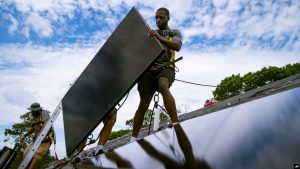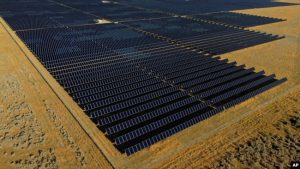
The Biden administration announced more than $80 million in funding Thursday in a push to produce more solar panels in the U.S., make solar energy available to more people, and pursue superior alternatives to the ubiquitous sparkly panels made with silicon.
The initiative, spearheaded by the U.S. Department of Energy (DOE) and known as Community solar, encompasses a variety of arrangements where renters and people who don’t control their rooftops can still get their electricity from solar power. Two weeks ago, Vice President Kamala Harris announced what the administration said was the largest community solar effort ever in the United States.
Now it is set to spend $52 million on 19 solar projects across a dozen states, including $10 million from the infrastructure law, as well as $30 million on technologies that will help integrate solar electricity into the grid.
The DOE also selected 25 teams to participate in a $10 million competition designed to fast-track the efforts of solar developers working on community solar projects.
The Inflation Reduction Act already offers incentives to build large solar generation projects, such as renewable energy tax credits. But Ali Zaidi, White House national climate adviser, said the new money focuses on meeting the nation’s climate goals in a way that benefits more communities.
“It’s lifting up our workers and our communities. And that’s, I think, what really excites us about this work,” Zaidi said. “It’s a chance not just to tackle the climate crisis, but to bring economic opportunity to every zip code of America.”
The investments will help people save on their electricity bills and make the electricity grid more reliable, secure, and resilient in the face of a changing climate, said Becca Jones-Albertus, director of the energy department’s Solar Energy Technologies Office.
Jones-Albertus said she’s particularly excited about the support for community solar projects, since half of Americans don’t live in a situation where they can buy their own solar and put in on the roof.

FILE – A solar farm is seen in Mona, Utah, Aug. 9, 2022.
Michael Jung, executive director of the ICF Climate Center agreed. “Community solar can help address equity concerns, as most current rooftop solar panels benefit owners of single-family homes,” he said.
In typical community solar projects, households can invest in or subscribe to part of a larger solar array offsite. “What we’re doing here is trying to unlock the community solar market,” Jones-Albertus said.
The U.S. has 5.3 gigawatts of installed community solar capacity currently, according to the latest estimates. The goal is that by 2025, five million households will have access to it — about three times as many as today — saving $1 billion on their electricity bills, according to Jones-Albertus.
The new funding also highlights investment in a next generation of solar technologies, intended to wring more electricity out of the same amount of solar panels. Currently only about 20% of the sun’s energy is converted to electricity in crystalline silicon solar cells, which is what most solar panels are made of. There has long been hope for higher efficiency, and today’s announcement puts some money towards developing two alternatives: perovskite and cadmium telluride (CdTe) solar cells. Zaidi said this will allow the U.S. to be “the innovation engine that tackles the climate crisis.”
Joshua Rhodes, a scientist at the University of Texas at Austin said the investment in perovskites is good news. They can be produced more cheaply than silicon and are far more tolerant of defects, he said. They can also be built into textured and curved surfaces, which opens up more applications for their use than traditional rigid panels. Most silicon is produced in China and Russia, Rhodes pointed out.
Cadmium telluride solar can be made quickly and at a low cost, but further research is needed to improve how efficient the material is at converting sunlight to electrons.
Cadmium is also toxic and people shouldn’t be exposed to it. Jones-Albertus said that in cadmium telluride solar technology, the compound is encapsulated in glass and additional protective layers.
The new funds will also help recycle solar panels and reuse rare earth elements and materials. “One of the most important ways we can make sure CdTe remains in a safe compound form is ensuring that all solar panels made in the U.S. can be reused or recycled at the end of their life cycle,” Jones-Albertus explained.
Recycling solar panels also reduces the need for mining, which damages landscapes and uses a lot of energy, in part to operate the heavy machinery. Eight of the projects in Thursday’s announcement focus on improving solar panel recycling, for a total of about $10 million.
Clean energy is a fit for every state in the country, the administration said. One solar project in Shungnak, Alaska, was able to eliminate the need to keep making electricity by burning diesel fuel, a method sometimes used in remote communities that is not healthy for people and contributes to climate change.
“Alaska is not a place that folks often think of when they think about solar, but this energy can be an economic and affordable resource in all parts of the country,” said Jones-Albertus.





